路由器配置命令
- 格式:docx
- 大小:234.95 KB
- 文档页数:8
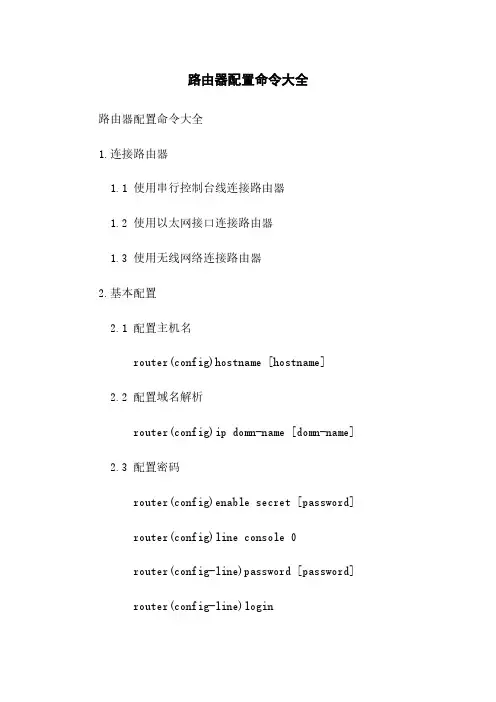
路由器配置命令大全路由器配置命令大全1.连接路由器1.1 使用串行控制台线连接路由器1.2 使用以太网接口连接路由器1.3 使用无线网络连接路由器2.基本配置2.1 配置主机名router(config)hostname [hostname]2.2 配置域名解析router(config)ip domn-name [domn-name] 2.3 配置密码router(config)enable secret [password] router(config)line console 0router(config-line)password [password] router(config-line)loginrouter(config-line)exitrouter(config)line vty 0 15router(config-line)password [password]router(config-line)loginrouter(config-line)exit2.4 配置管理IP地质router(config)interface [interface]router(config-if)ip address [ip-address] [subnet-mask]router(config-if)no shutdown3.网络协议配置3.1 配置静态路由router(config)ip route [destination-network] [subnet-mask] [next-hop]3.2 配置动态路由router(config)router [routing-protocol]router(config-router)network [network-address] [subnet-mask]3.3 配置带宽管理router(config)interface [interface]router(config-if)bandwidth [bandwidth-in-kbps]3.4 配置ACL(访问控制列表)router(config)access-list [access-list-number] [permit/deny] [source-network] [source-wildcard]4.NAT(网络地质转换)配置4.1 配置静态NATrouter(config)ip nat inside source static [inside-local-address] [outside-global-address]4.2 配置动态NATrouter(config)ip nat pool [pool-name] [start-ip-address] [end-ip-address] netmask [subnet-mask]router(config)ip nat inside source list [access-list] pool [pool-name]4.3 配置PAT(端口地质转换)router(config)interface [interface]router(config-if)ip nat insiderouter(config)interface [interface]router(config-if)ip nat outside5.VLAN(虚拟局域网)配置5.1 配置VLANrouter(config)vlan [vlan-id]router(config-vlan)name [vlan-name]5.2 配置接口VLANrouter(config)interface [interface]router(config-if)switchport mode accessrouter(config-if)switchport access vlan [vlan-id]5.3 配置Trunk接口router(config)interface [interface]router(config-if)switchport mode trunkrouter(config-if)switchport trunk allowed vlan [vlan-list]6.特定协议配置6.1 配置DHCP(动态主机配置协议)router(config)ip dhcp pool [pool-name]router(dhcp-config)network [network-address] [subnet-mask]router(dhcp-config)default-router [default-gateway]router(dhcp-config)dns-server [dns-server-ip]6.2 配置NTP(网络时间协议)router(config)ntp server [ntp-server-ip]router(config)ntp update-calendar6.3 配置SNMP(简单网络管理协议)router(config)snmp-server community [community-string] [ro/rw]router(config)snmp-server host [host-ip] [community-string]7.安全配置7.1 配置SSH(安全外壳协议)router(config)hostname [hostname]router(config)ip domn-name [domn-name]router(config)crypto key generate rsarouter(config)ip ssh version 2router(config)line vty 0 15router(config-line)transport input sshrouter(config-line)login localrouter(config-line)exit7.2 配置防火墙router(config)access-list [access-list-number] [permit/deny] [source-network] [source-wildcard] router(config)interface [interface]router(config-if)ip access-group [access-list-number] [in/out]附件:无法律名词及注释:- IP地质:Internet Protocol Address,互联网协议地质,用于标识网络上主机的唯一数字标识。
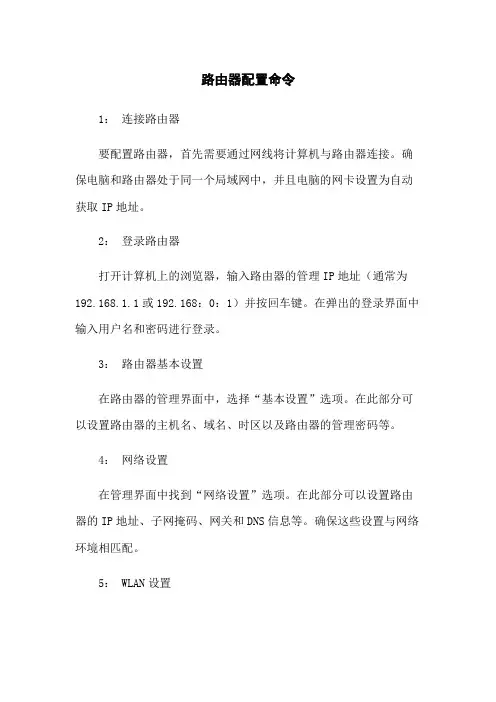
路由器配置命令1:连接路由器要配置路由器,首先需要通过网线将计算机与路由器连接。
确保电脑和路由器处于同一个局域网中,并且电脑的网卡设置为自动获取IP地址。
2:登录路由器打开计算机上的浏览器,输入路由器的管理IP地址(通常为192.168.1.1或192.168:0:1)并按回车键。
在弹出的登录界面中输入用户名和密码进行登录。
3:路由器基本设置在路由器的管理界面中,选择“基本设置”选项。
在此部分可以设置路由器的主机名、域名、时区以及路由器的管理密码等。
4:网络设置在管理界面中找到“网络设置”选项。
在此部分可以设置路由器的IP地址、子网掩码、网关和DNS信息等。
确保这些设置与网络环境相匹配。
5: WLAN设置如果路由器支持无线网络功能,可以在“WLAN设置”选项中进行相关设置。
包括无线网络的SSID名称、加密方式及密码等。
6:接口设置在管理界面中找到“接口设置”选项。
在此部分可以设置路由器的LAN口、WAN口、VLAN等接口相关的配置。
7:安全设置保护路由器的安全至关重要,可以在“安全设置”选项中进行相关的配置。
包括设置防火墙、启用ACL以及安全登录等选项。
8:服务设置在管理界面中找到“服务设置”选项。
在此部分可以设置路由器的DHCP服务、DNS代理、动态DNS等相关服务。
9: NAT设置如果需要进行网络地址转换(NAT)配置,可以在“NAT设置”选项中进行相关设置。
包括端口映射、虚拟服务器等。
10:路由设置在管理界面中找到“路由设置”选项。
在此部分可以进行路由设置相关的配置,如静态路由等。
附件:本文档不附带任何附件。
法律名词及注释:1: IP地址:互联网协议地址,用于标识计算机或网络设备在网络上的唯一标识。
2:子网掩码:用于将IP地址分成网络地址和主机地址两部分的32位二进制数。
3:网关:连接两个不同网络的设备,用于在网络之间进行中转和交换数据。
4: DNS:域名系统,将域名解析为IP地址的系统。
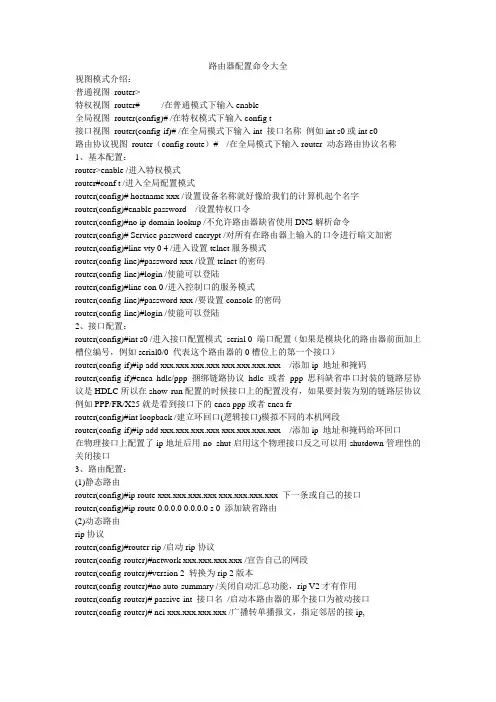
路由器配置命令大全视图模式介绍:普通视图router>特权视图router# /在普通模式下输入enable全局视图router(config)# /在特权模式下输入config t接口视图router(config-if)# /在全局模式下输入int 接口名称例如int s0或int e0路由协议视图router(config-route)# /在全局模式下输入router 动态路由协议名称1、基本配置:router>enable /进入特权模式router#conf t /进入全局配置模式router(config)# hostname xxx /设置设备名称就好像给我们的计算机起个名字router(config)#enable password /设置特权口令router(config)#no ip domain lookup /不允许路由器缺省使用DNS解析命令router(config)# Service password-encrypt /对所有在路由器上输入的口令进行暗文加密router(config)#line vty 0 4 /进入设置telnet服务模式router(config-line)#password xxx /设置telnet的密码router(config-line)#login /使能可以登陆router(config)#line con 0 /进入控制口的服务模式router(config-line)#password xxx /要设置console的密码router(config-line)#login /使能可以登陆2、接口配置:router(config)#int s0 /进入接口配置模式serial 0 端口配置(如果是模块化的路由器前面加上槽位编号,例如serial0/0 代表这个路由器的0槽位上的第一个接口)router(config-if)#ip add xxx.xxx.xxx.xxx xxx.xxx.xxx.xxx /添加ip 地址和掩码router(config-if)#enca hdlc/ppp 捆绑链路协议hdlc 或者ppp 思科缺省串口封装的链路层协议是HDLC所以在show run配置的时候接口上的配置没有,如果要封装为别的链路层协议例如PPP/FR/X25就是看到接口下的enca ppp或者enca frrouter(config)#int loopback /建立环回口(逻辑接口)模拟不同的本机网段router(config-if)#ip add xxx.xxx.xxx.xxx xxx.xxx.xxx.xxx /添加ip 地址和掩码给环回口在物理接口上配置了ip地址后用no shut启用这个物理接口反之可以用shutdown管理性的关闭接口3、路由配置:(1)静态路由router(config)#ip route xxx.xxx.xxx.xxx xxx.xxx.xxx.xxx 下一条或自己的接口router(config)#ip route 0.0.0.0 0.0.0.0 s 0 添加缺省路由(2)动态路由rip协议router(config)#router rip /启动rip协议router(config-router)#network xxx.xxx.xxx.xxx /宣告自己的网段router(config-router)#version 2 转换为rip 2版本router(config-router)#no auto-summary /关闭自动汇总功能,rip V2才有作用router(config-router)# passive-int 接口名/启动本路由器的那个接口为被动接口router(config-router)# nei xxx.xxx.xxx.xxx /广播转单播报文,指定邻居的接ip,igrp协议-----内部网关路由协议(IGRP:Interior Gateway Routing Protocol)router(config)#router igrp xxx /启动igrp协议router(config-router)#network xxx.xxx.xxx.xxx /宣告自己的网段router(config-router)#variance xxx /调整倍数因子,使用不等价的负载均衡eigrp---Enhanced Interior Gateway Routing Protocol(增强网关内部路由线路协议)router(config)#router eigrp xxx /启动协议router(config-router)#network xxx.xxx.xxx.xxx /宣告自己的网段router(config-router)#variance xxx /调整倍数因子,使用不等价的负载均衡router(config-router)#no auto-summary /关闭自动汇总功能ospf协议----开放最短路径协议(OSPF)协议router(config)#router ospf xxx /启动协议启动一个OSPF协议进程router(config-router)#network xxx.xxx.xxx.xxx area xxx /宣告自己的接口或网段在ospf的区域中,可以把不同接口宣告在不同区域中router(config-router)#router-id xxx.xxx.xxx.xxx /配置路由的idrouter(config-router)#area xxx stub /配置xxx区域为末梢区域,加入这个区域的路由器全部要配置这个条命令router(config-router)#area xxx stub no-summary /配置xxx区域为完全末梢区域,只在ABR上配置router(config-router)#area xxx nssa /配置xxx区域为非纯末梢区域,加入这个区域的路由器全部要配置这个条命令router(config-router)#area xxx nssa no-summary /配置xxx区域为完全非纯末梢区域,只在ABR上配置,并发布缺省路由信息进入这个区域内的路由器4、保存当前修改/运行的配置:router#write /将RAM中的当前配置存储到NVRAM中,下次路由器启动就是执行保存的配置router#Copy running-config startup-config /命令与write效果一样5、一般的常用命令router(config-if)#exitrouter(config)#router(config-router)#exitrouter(config)#router(config-line)#exitrouter(config)#router(config)#exitrouter#exit命令/从接口、协议、line等视图模式下退回到全局配置模式,或从全局配置模式退回到特权模式router(config-if)#endrouter(config-router)#endrouter(config-line)#endrouter#end命令/从任何视图直接回到特权模式router#Logout /退出当前路由器登陆模式相对与windows的注销router#reload /重新启动路由器(热启动)冷启动就是关闭路由器再打开电源开关特权模式下:router#show ip route /查看当前的路由表router#clear ip route * /清楚当前的路由表router#show ip protocol /查看当前路由器运行的动态路由协议情况router#show ip int brief /查看当前的路由器的接口ip地址启用情况router#show running-config /查看当前运行配置router#show startup-config /查看启动配置router#debug ip pack /打开ip报文的调试router#terminal monitor /输出到终端上显示调试信息router#show ip eigrp neighbors /查看eigrp协议的邻居表router#show ip eigrp top //查看eigrp协议的拓朴表router#show ip eigrp interface /查看当前路由器运行eigrp协议的接口情况router#show ip ospf neighbor /查看当前路由器的ospf协议的邻居表router#show ip ospf interface /查看当前路由器运行ospf协议的接口情况router#clear ip ospf process /清楚当前路由器ospf协议的进程router#Show interfaces /显示设置在路由器和访问服务器上所有接口的统计信息. 显示路由器上配置的所有接口的状态router#Show interfaces serial /显示关于一个串口的信息router#Show ip interface /列出一个接口的IP信息和状态的小结, 列出接口的状态和全局参数。
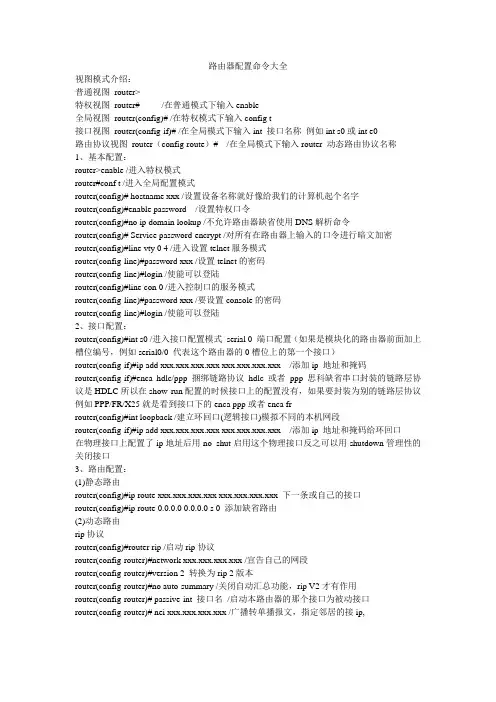
路由器配置命令大全视图模式介绍:普通视图router>特权视图router# /在普通模式下输入enable全局视图router(config)# /在特权模式下输入config t接口视图router(config-if)# /在全局模式下输入int 接口名称例如int s0或int e0路由协议视图router(config-route)# /在全局模式下输入router 动态路由协议名称1、基本配置:router>enable /进入特权模式router#conf t /进入全局配置模式router(config)# hostname xxx /设置设备名称就好像给我们的计算机起个名字router(config)#enable password /设置特权口令router(config)#no ip domain lookup /不允许路由器缺省使用DNS解析命令router(config)# Service password-encrypt /对所有在路由器上输入的口令进行暗文加密router(config)#line vty 0 4 /进入设置telnet服务模式router(config-line)#password xxx /设置telnet的密码router(config-line)#login /使能可以登陆router(config)#line con 0 /进入控制口的服务模式router(config-line)#password xxx /要设置console的密码router(config-line)#login /使能可以登陆2、接口配置:router(config)#int s0 /进入接口配置模式serial 0 端口配置(如果是模块化的路由器前面加上槽位编号,例如serial0/0 代表这个路由器的0槽位上的第一个接口)router(config-if)#ip add xxx.xxx.xxx.xxx xxx.xxx.xxx.xxx /添加ip 地址和掩码router(config-if)#enca hdlc/ppp 捆绑链路协议hdlc 或者ppp 思科缺省串口封装的链路层协议是HDLC所以在show run配置的时候接口上的配置没有,如果要封装为别的链路层协议例如PPP/FR/X25就是看到接口下的enca ppp或者enca frrouter(config)#int loopback /建立环回口(逻辑接口)模拟不同的本机网段router(config-if)#ip add xxx.xxx.xxx.xxx xxx.xxx.xxx.xxx /添加ip 地址和掩码给环回口在物理接口上配置了ip地址后用no shut启用这个物理接口反之可以用shutdown管理性的关闭接口3、路由配置:(1)静态路由router(config)#ip route xxx.xxx.xxx.xxx xxx.xxx.xxx.xxx 下一条或自己的接口router(config)#ip route 0.0.0.0 0.0.0.0 s 0 添加缺省路由(2)动态路由rip协议router(config)#router rip /启动rip协议router(config-router)#network xxx.xxx.xxx.xxx /宣告自己的网段router(config-router)#version 2 转换为rip 2版本router(config-router)#no auto-summary /关闭自动汇总功能,rip V2才有作用router(config-router)# passive-int 接口名/启动本路由器的那个接口为被动接口router(config-router)# nei xxx.xxx.xxx.xxx /广播转单播报文,指定邻居的接ip,igrp协议-----内部网关路由协议(IGRP:Interior Gateway Routing Protocol)router(config)#router igrp xxx /启动igrp协议router(config-router)#network xxx.xxx.xxx.xxx /宣告自己的网段router(config-router)#variance xxx /调整倍数因子,使用不等价的负载均衡eigrp---Enhanced Interior Gateway Routing Protocol(增强网关内部路由线路协议)router(config)#router eigrp xxx /启动协议router(config-router)#network xxx.xxx.xxx.xxx /宣告自己的网段router(config-router)#variance xxx /调整倍数因子,使用不等价的负载均衡router(config-router)#no auto-summary /关闭自动汇总功能ospf协议----开放最短路径协议(OSPF)协议router(config)#router ospf xxx /启动协议启动一个OSPF协议进程router(config-router)#network xxx.xxx.xxx.xxx area xxx /宣告自己的接口或网段在ospf的区域中,可以把不同接口宣告在不同区域中router(config-router)#router-id xxx.xxx.xxx.xxx /配置路由的idrouter(config-router)#area xxx stub /配置xxx区域为末梢区域,加入这个区域的路由器全部要配置这个条命令router(config-router)#area xxx stub no-summary /配置xxx区域为完全末梢区域,只在ABR上配置router(config-router)#area xxx nssa /配置xxx区域为非纯末梢区域,加入这个区域的路由器全部要配置这个条命令router(config-router)#area xxx nssa no-summary /配置xxx区域为完全非纯末梢区域,只在ABR上配置,并发布缺省路由信息进入这个区域内的路由器4、保存当前修改/运行的配置:router#write /将RAM中的当前配置存储到NVRAM中,下次路由器启动就是执行保存的配置router#Copy running-config startup-config /命令与write效果一样5、一般的常用命令router(config-if)#exitrouter(config)#router(config-router)#exitrouter(config)#router(config-line)#exitrouter(config)#router(config)#exitrouter#exit命令/从接口、协议、line等视图模式下退回到全局配置模式,或从全局配置模式退回到特权模式router(config-if)#endrouter(config-router)#endrouter(config-line)#endrouter#end命令/从任何视图直接回到特权模式router#Logout /退出当前路由器登陆模式相对与windows的注销router#reload /重新启动路由器(热启动)冷启动就是关闭路由器再打开电源开关特权模式下:router#show ip route /查看当前的路由表router#clear ip route * /清楚当前的路由表router#show ip protocol /查看当前路由器运行的动态路由协议情况router#show ip int brief /查看当前的路由器的接口ip地址启用情况router#show running-config /查看当前运行配置router#show startup-config /查看启动配置router#debug ip pack /打开ip报文的调试router#terminal monitor /输出到终端上显示调试信息router#show ip eigrp neighbors /查看eigrp协议的邻居表router#show ip eigrp top //查看eigrp协议的拓朴表router#show ip eigrp interface /查看当前路由器运行eigrp协议的接口情况router#show ip ospf neighbor /查看当前路由器的ospf协议的邻居表router#show ip ospf interface /查看当前路由器运行ospf协议的接口情况router#clear ip ospf process /清楚当前路由器ospf协议的进程router#Show interfaces /显示设置在路由器和访问服务器上所有接口的统计信息. 显示路由器上配置的所有接口的状态router#Show interfaces serial /显示关于一个串口的信息router#Show ip interface /列出一个接口的IP信息和状态的小结, 列出接口的状态和全局参数。
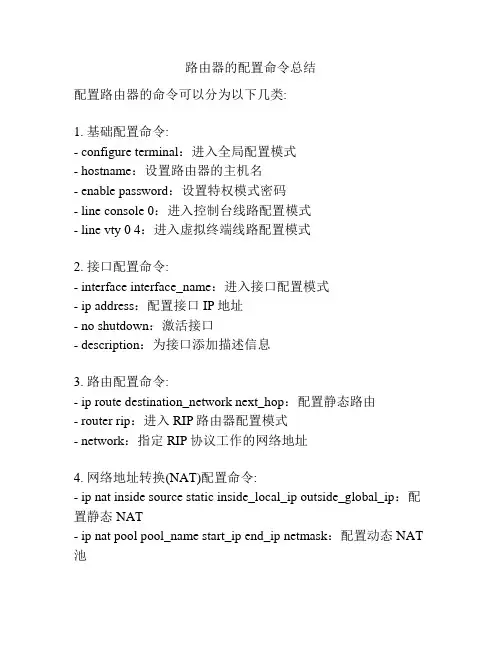
路由器的配置命令总结配置路由器的命令可以分为以下几类:1. 基础配置命令:- configure terminal:进入全局配置模式- hostname:设置路由器的主机名- enable password:设置特权模式密码- line console 0:进入控制台线路配置模式- line vty 0 4:进入虚拟终端线路配置模式2. 接口配置命令:- interface interface_name:进入接口配置模式- ip address:配置接口IP地址- no shutdown:激活接口- description:为接口添加描述信息3. 路由配置命令:- ip route destination_network next_hop:配置静态路由- router rip:进入RIP路由器配置模式- network:指定RIP协议工作的网络地址4. 网络地址转换(NAT)配置命令:- ip nat inside source static inside_local_ip outside_global_ip:配置静态NAT- ip nat pool pool_name start_ip end_ip netmask:配置动态NAT 池5. 访问控制列表(ACL)配置命令:- access-list acl_number {deny | permit} source destination:创建ACL规则- interface interface_name:进入接口配置模式- ip access-group acl_number {in | out}:应用ACL到接口6. VLAN配置命令:- vlan vlan_id:创建VLAN- switchport mode {access | trunk}:配置接口模式7. 安全配置命令:- enable secret:设置特权模式加密密码- username username password password:创建本地用户8. 特定协议配置命令:- router ospf process_ID:进入OSPF路由器配置模式- network network_address wildcard_mask area area_number:配置OSPF网络- router bgp autonomous_system_number:进入BGP路由器配置模式- neighbor ip_address remote-as autonomous_system_number:配置BGP邻居以上是一些常见的路由器配置命令,不同型号和品牌的路由器可能会有一些差异,具体命令请参考相应的操作手册或文档。
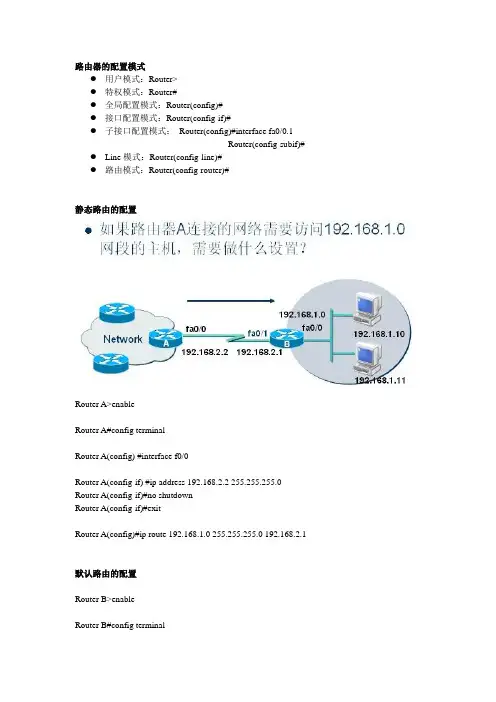
路由器的配置模式●用户模式:Router>●特权模式:Router#●全局配置模式:Router(config)#●接口配置模式:Router(config-if)#●子接口配置模式:Router(config)#interface fa0/0.1Router(config-subif)#●Line模式:Router(config-line)#●路由模式:Router(config-router)#静态路由的配置Router A>enableRouter A#config terminalRouter A(config) #interface f0/0Router A(config-if) #ip address 192.168.2.2 255.255.255.0 Router A(config-if)#no shutdownRouter A(config-if)#exitRouter A(config)#ip route 192.168.1.0 255.255.255.0 192.168.2.1 默认路由的配置Router B>enableRouter B#config terminalRouter B(config) #interface f0/1Router B(config-if) #ip address 192.168.2.1 255.255.255.0Router B(config-if)#no shutdownRouter B(config-if)#exitRouter B(config) #interface f0/0Router B(config-if) #ip address 192.168.1.1 255.255.255.0Router B(config-if)#no shutdownRouter B(config-if)#exitRouter B(config)#ip route 0.0.0.0 0.0.0.0 192.168.2.2查看路由表RouterA#show ip routeCodes: C - connected, S - static, R - RIP, M - mobile, B - BGPD - EIGRP, EX - EIGRP external, O - OSPF, IA - OSPF inter areaN1 - OSPF NSSA external type 1, N2 - OSPF NSSA external type 2E1 - OSPF external type 1, E2 - OSPF external type 2i - IS-IS, su - IS-IS summary, L1 - IS-IS level-1, L2 - IS-IS level-2ia - IS-IS inter area, * - candidate default, U - per-user static routeo - ODR, P - periodic downloaded static routeGateway of last resort is not setS 192.168.1.0/24 [1/0] via 192.168.2.1C 192.168.2.0/24 is directly connected, FastEthernet0/0RouterA#show ip routeCodes: C - connected, S - static, R - RIP, M - mobile, B - BGPD - EIGRP, EX - EIGRP external, O - OSPF, IA - OSPF inter areaN1 - OSPF NSSA external type 1, N2 - OSPF NSSA external type 2E1 - OSPF external type 1, E2 - OSPF external type 2i - IS-IS, su - IS-IS summary, L1 - IS-IS level-1, L2 - IS-IS level-2ia - IS-IS inter area, * - candidate default, U - per-user static routeo - ODR, P - periodic downloaded static routeGateway of last resort is not setS 192.168.1.0/24 [1/0] via 192.168.2.1C 192.168.2.0/24 is directly connected, FastEthernet0/0配置路由器的控制台会话●配置控制台会话时间teacher(config)#line console 0teacher(config_line)#exec-timeout 0 0●配置控制台输出日志同步teacher(config)#line console 0teacher(config_line)#logging synchronous●配置禁用DNSteacher(config)#no ip domain-lookup路由器与交换机之间的单臂路由Router(config)# interface f0/0.1Router(config-subif)# encapsolution dot1q 1Router(config-subif)# ip address 192.168.1.1 255.255.255.0Router(config)# interface f0/0.2Router(config-subif)# encapsolution dot1q 2Router(config-subif)# ip address 192.168.2.1 255.255.255.0。
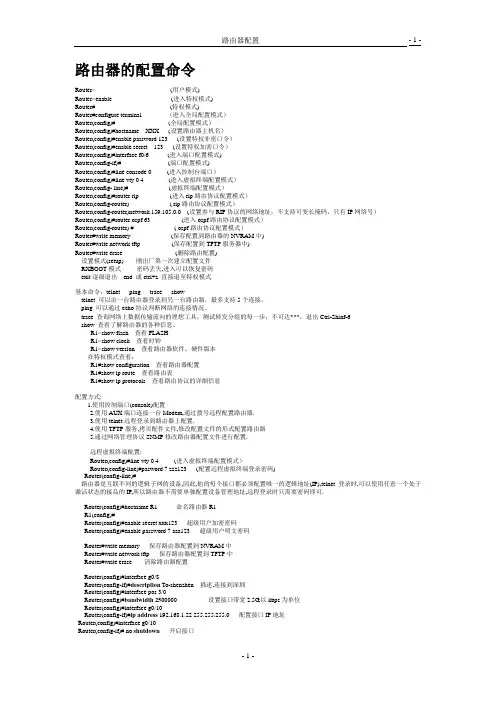
路由器的配置命令Router> (用户模式)Router>enable (进入特权模式)Router# (特权模式)Router#configure terminal (进入全局配置模式)Router(config)# (全局配置模式)Router(config)#hostname XXX (设置路由器主机名)Router(config)#enable password 123 (设置特权非密口令)Router(config)#enable secret 123 (设置特权加密口令)Router(config)#interface f0/6 (进入端口配置模式)Router(config-if)# (端口配置模式)Router(config)#line consode 0 (进入控制台端口)Router(config)#line vty 0 4 (进入虚拟终端配置模式)Router(config- line)# (虚拟终端配置模式)Router(config)#router rip (进入rip路由协议配置模式)Router(config-router) ( rip路由协议配置模式)Router(config-router)network 159.105.0.0 (设置参与RIP协议的网络地址,不支持可变长掩码,只有IP网络号)Router(config)#router ospf 63 (进入ospf路由协议配置模式)Router(config-router) # ( ospf路由协议配置模式)Router#write memory (保存配置到路由器的NVRAM中)Router#write network tftp (保存配置到TFTP服务器中)Router#write erase (删除路由配置)设置模式(setup) 刚出厂第一次建立配置文件RXBOOT模式密码丢失,进入可以恢复密码exit逐级退出end 或ctrl+z 直接退至特权模式基本命令:telnet ping trace showtelnet 可以由一台路由器登录到另一台路由器,最多支持5个连接。
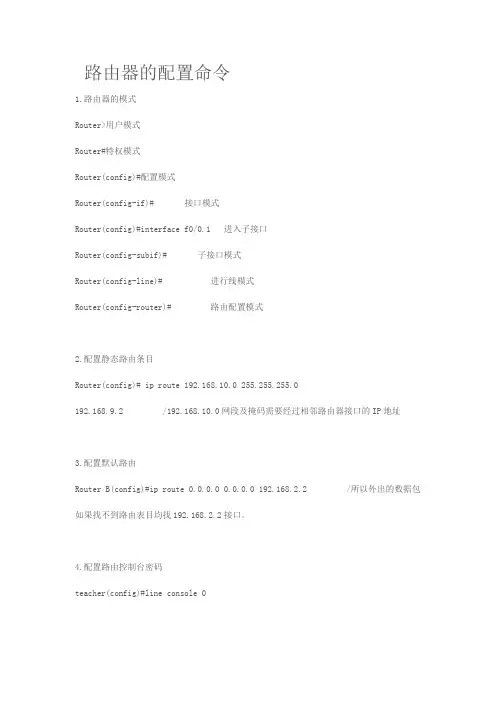
路由器的配置命令1.路由器的模式Router>用户模式Router#特权模式Router(config)#配置模式Router(config-if)# 接口模式Router(config)#interface f0/0.1 进入子接口Router(config-subif)# 子接口模式Router(config-line)# 进行线模式Router(config-router)# 路由配置模式2.配置静态路由条目Router(config)# ip route 192.168.10.0 255.255.255.0 192.168.9.2 /192.168.10.0网段及掩码需要经过相邻路由器接口的IP地址3.配置默认路由Router B(config)#ip route 0.0.0.0 0.0.0.0 192.168.2.2 /所以外出的数据包如果找不到路由表目均找192.168.2.2接口。
4.配置路由控制台密码teacher(config)#line console 0teacher(config-line)#loginteacher(config-line)password ciscoteacher(config)#enable password cisco /配置特权模式密码teacher(config)#enable secret 1234 /配置加密保存的密码teacher(config)#service password-encryption / 对所有密码加密5.配置控制台会话时间teacher(config)#line console 0teacher(config-line)exec-timeout 0 06.配置控制台输出日志同步teacher(config)#line console 0teacher(config-line)#logging synchronous7.路由密码恢复(1)进入ROM Monitor 模式(2)修改配置寄存器的值,启动是绕过 startup-config文件rommon1>confreg ox2140rommon2>reset(3)用startup-config覆盖running-configROuter#copy starup-config running-config修改密码Router(config)#enable password cisco(4)修改配置寄存器的值Router(config)#config-register ox21028.动态路由配置(1)截断超时(2)打开接口(3)为接口设置IP 地址Router(config)#interface f0/0Router(config-if)#ip address 192.168.1.1Router(configif)#no shutdown(4)启动RIP进程,并宣告主网络号Router(config)#router ripRouter(config-router)#network 192.68.1.09.单臂路由配置Router(config)#interface f0/0.1router(config-subif)#encapsolution dotlq 1 :子接口封装dot1q针对的是VLAN1Router(config-subif)#ip address 192.168.1.1 255.255.255.0 :设置VLAN的网关地址Router(config)#interface f0/0.2router(config-subif)# encapsolution dotlq 2 子网接口封装do1q针对的是VLAN2 Router(config-subif)# 192.168.2.1 255.255.255.0 :设置VLAN2的网关地址路由器的操作系统,它是一个功能非常强大的系统,特别是在一些高档的路由器中,它具有相当丰富的操作命令,就像我们的DOS系统一样。
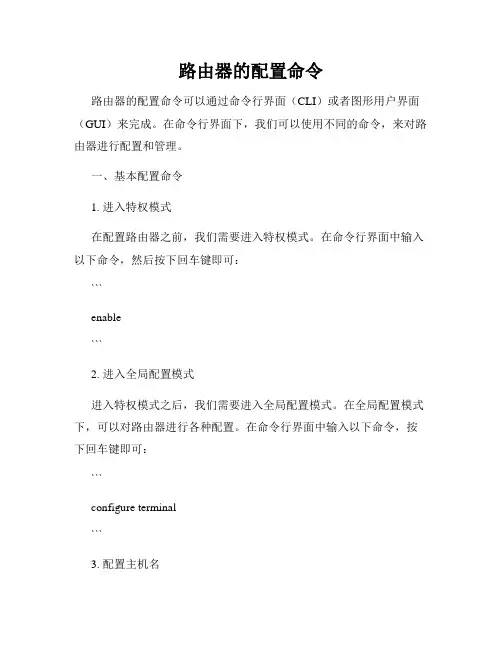
路由器的配置命令路由器的配置命令可以通过命令行界面(CLI)或者图形用户界面(GUI)来完成。
在命令行界面下,我们可以使用不同的命令,来对路由器进行配置和管理。
一、基本配置命令1. 进入特权模式在配置路由器之前,我们需要进入特权模式。
在命令行界面中输入以下命令,然后按下回车键即可:```enable```2. 进入全局配置模式进入特权模式之后,我们需要进入全局配置模式。
在全局配置模式下,可以对路由器进行各种配置。
在命令行界面中输入以下命令,按下回车键即可:```configure terminal```3. 配置主机名在全局配置模式下,我们可以为路由器配置一个唯一的主机名,以区分其他路由器。
在命令行界面中输入以下命令,按下回车键即可:```hostname Router1```这里的"Router1"可以替换为你想要的主机名。
4. 配置密码为了保护路由器的安全,我们可以为路由器配置密码。
以下是两种常用的密码配置命令:为特权模式设置密码:```enable secret password```为虚拟终端线路设置密码:```line vty 0 4password passwordlogin```这里的"password"可以替换为你想要的密码。
二、接口配置命令1. 进入接口配置模式在全局配置模式下,我们可以进入接口配置模式,对特定接口进行配置。
以下是两个常用的进入接口模式的命令:进入以太网接口配置模式:```interface Ethernet0/0```进入串口接口配置模式:```interface Serial0/0```2. 配置IP地址在接口配置模式下,我们可以为接口配置IP地址。
以下是一个配置IP地址的命令示例:```ip address 192.168.0.1 255.255.255.0```这里的"192.168.0.1"和"255.255.255.0"可以替换为你想要的IP地址和子网掩码。
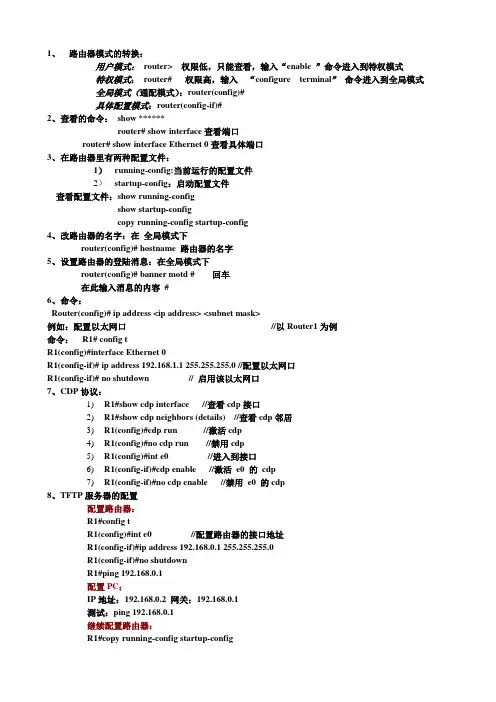
1、路由器模式的转换:用户模式:router> 权限低,只能查看,输入“enable ”命令进入到特权模式特权模式:router# 权限高,输入“configure terminal”命令进入到全局模式全局模式(通配模式):router(config)#具体配置模式:router(config-if)#2、查看的命令:show ******router# show interface查看端口router# show interface Ethernet 0查看具体端口3、在路由器里有两种配置文件:1)running-config:当前运行的配置文件2)startup-config:启动配置文件查看配置文件:show running-configshow startup-configcopy running-config startup-config4、改路由器的名字:在全局模式下router(config)# hostname 路由器的名字5、设置路由器的登陆消息:在全局模式下router(config)# banner motd # 回车在此输入消息的内容#6、命令:Router(config)# ip address <ip address> <subnet mask>例如:配置以太网口//以Router1为例命令:R1# config tR1(config)#interface Ethernet 0R1(config-if)# ip address 192.168.1.1 255.255.255.0 //配置以太网口R1(config-if)# no shutdown // 启用该以太网口7、CDP协议:1)R1#show cdp interface //查看cdp接口2)R1#show cdp neighbors (details) //查看cdp邻居3)R1(config)#cdp run //激活cdp4)R1(config)#no cdp run //禁用cdp5)R1(config)#int e0 //进入到接口6)R1(config-if)#cdp enable //激活e0 的cdp7)R1(config-if)#no cdp enable //禁用e0 的cdp8、TFTP服务器的配置配置路由器:R1#config tR1(config)#int e0 //配置路由器的接口地址R1(config-if)#ip address 192.168.0.1 255.255.255.0R1(config-if)#no shutdownR1#ping 192.168.0.1配置PC:IP地址:192.168.0.2 网关:192.168.0.1测试:ping 192.168.0.1继续配置路由器:R1#copy running-config startup-configR1#copy startup-config tftpR1#erase startup-configR1# copy tftp startup-configR1#show startup-config9、路由器口令的设置:1)控制台口令:R1#config terminalR1(config)#line con 0R1(config-line)#loginR1(config-line)#password 密码2)enable 口令R1#config terminalR1(config)#enable password 密码3)远程登陆口令R1#config terminalR1(config)#line vty 0 4R1(config-line)#loginR1(config-line)#password 密码10、远程登陆:从一台计算机登陆到远端的另一台计算机,使用另一台计算机就像使用自己的计算机一样。
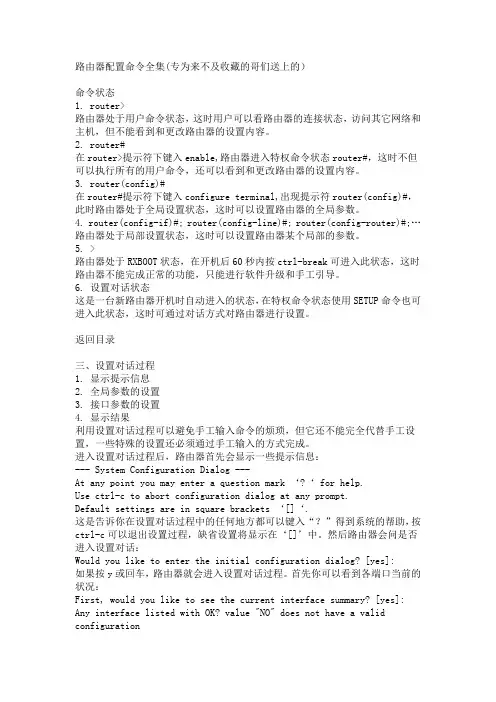
路由器配置命令全集(专为来不及收藏的哥们送上的)命令状态1. router>路由器处于用户命令状态,这时用户可以看路由器的连接状态,访问其它网络和主机,但不能看到和更改路由器的设置内容。
2. router#在router>提示符下键入enable,路由器进入特权命令状态router#,这时不但可以执行所有的用户命令,还可以看到和更改路由器的设置内容。
3. router(config)#在router#提示符下键入configure terminal,出现提示符router(config)#,此时路由器处于全局设置状态,这时可以设置路由器的全局参数。
4. router(config-if)#; router(config-line)#; router(config-router)#;… 路由器处于局部设置状态,这时可以设置路由器某个局部的参数。
5. >路由器处于RXBOOT状态,在开机后60秒内按ctrl-break可进入此状态,这时路由器不能完成正常的功能,只能进行软件升级和手工引导。
6. 设置对话状态这是一台新路由器开机时自动进入的状态,在特权命令状态使用SETUP命令也可进入此状态,这时可通过对话方式对路由器进行设置。
返回目录三、设置对话过程1. 显示提示信息2. 全局参数的设置3. 接口参数的设置4. 显示结果利用设置对话过程可以避免手工输入命令的烦琐,但它还不能完全代替手工设置,一些特殊的设置还必须通过手工输入的方式完成。
进入设置对话过程后,路由器首先会显示一些提示信息:--- System Configuration Dialog ---At any point you may enter a quest ion mark ‘?‘ for help.Use ctrl-c to abort configuration dialog at any prompt.Default settings are in square brackets ‘[]‘.这是告诉你在设置对话过程中的任何地方都可以键入“?”得到系统的帮助,按ctrl-c可以退出设置过程,缺省设置将显示在‘[]’中。
查看路由配置的几种命令在计算机网络中,路由配置是非常重要的一项技能。
路由配置是指将数据包从源地址传输到目标地址的过程。
了解并熟练掌握各种路由配置命令是网络工程师的必备技能。
本文将介绍几种常用的查看路由配置的命令,以便更好地理解网络结构和配置。
1. ping 命令ping 命令是网络诊断中最常用的命令之一。
它可以测试数据包从一台计算机传输到另一台计算机的延迟和丢包率。
在查看路由配置时,可以使用 ping 命令来测试不同网络之间的连通性。
例如,可以使用 ping 命令测试从本地计算机到远程服务器的连通性。
2. traceroute 命令traceroute 命令可以显示数据包从一台计算机传输到另一台计算机所经历的所有中间路由器。
在查看路由配置时,可以使用traceroute 命令来了解数据包在网络中的传输路径。
3. route 命令route 命令是网络管理员最常用的命令之一。
它可以显示当前计算机的路由表,并允许管理员配置网络地址和路由。
在查看路由配置时,可以使用 route 命令来查看当前的路由配置,并根据实际情况进行修改。
4. ifconfig 命令ifconfig 命令是 Linux 系统下常用的网络配置命令。
它可以显示计算机的网络配置信息,包括网络接口、IP 地址、子网掩码、广播地址等。
在查看路由配置时,可以使用 ifconfig 命令来查看计算机的网络配置信息,以便更好地了解网络结构。
5. command -p optioncommand -p option 是 Windows 系统下查看路由配置的命令。
它允许管理员查看 Windows 系统下的路由配置信息,并允许管理员进行配置。
在查看路由配置时,可以使用 command -p option 命令来查看 Windows 系统的路由配置信息,并根据实际情况进行修改。
以上是几种常用的查看路由配置的命令。
网络管理员可以使用这些命令来了解网络结构和配置,以便更好地管理和优化网络性能。
路由器配置命令路由器是局域网络与广域网络(或城域网)相连的必备设备,也是网络管理员必备的技能之一。
路由器的命令实际上难度和早期的dos操作系统或命令行的linux比较接近,但功能上要比以上操作系统单一很多。
不同厂商的路由器命令有些许差别,但功能性的东西没有本质的差别。
以下是常用路由器配置命令。
1. 进入特权模式 enablerouter > enablerouter #2. 进入全局配置模式 configure terminalrouter > enablerouter #configure terminalrouter (config)#3. 重命名 hostname routera 以routerA为例router > enablerouter #configure terminalrouter(config)#hostname routerArouterA (config)#4. 配置使能口令 enable password cisco 以cisco为例router > enablerouter #configure terminalrouter(config)#hostname routerArouterA (config)# enable password cisco5. 配置使能密码 enable secret ciscolab 以cicsolab为例router > enablerouter #configure terminalrouter(config)#hostname routerArouterA (config)# enable secret ciscolab6. 进入路由器某一端口 interface fastethernet 0/1router > enablerouter #configure terminalrouter(config)#hostname routerArouterA (config)# interface fastethernet 0/1routerA (config-if)#进入路由器的某一子端口 interface fastethernet 0/1.1 以1端口的1子端口为例router > enablerouter #configure terminalrouter(config)#hostname routerArouterA (config)# interface fastehernet 0/1.17. 设置端口ip地址信息router > enablerouter #configure terminalrouter(config)#hostname routerArouterA(config)# interface fastethernet 0/1 以1端口为例routerA (config-if)#ip address 192.168.1.1 255.255.255.0 配置交换机端口ip和子网掩码routerA (config-if)#no shut 启动此接口routerA (config-if)#exit8. 查看命令 showrouter > enablerouter # show version 察看系统中的所有版本信息show controllers serial + 编号查看串口类型show ip route 查看路由器的路由表9. cdp相关命令router > enablerouter # show cdp 查看设备的cdp全局配置信息show cdp traffic 查看有关cdp包的统计信息show cdp neighbors 列出与设备相连的cisco设备10. csico2600的密码恢复重新启动路由器,在启动过程中按下ctrl+break键,使路由器进入rom monitor模式。
路由器配置常用命令汇总路由器是连接网络设备的关键组件,用于将网络流量从一个网络传输到另一个网络。
配置路由器是网络管理员的重要任务之一,通过配置路由器,管理员可以确保网络安全,优化网络性能和管理网络流量。
下面是常用的路由器配置命令的汇总。
1.基本设置命令- enable:进入特权模式- configure terminal:进入全局配置模式- hostname [name]:设置路由器主机名- interface [interface-name]:进入接口配置模式- ip address [ip-address] [subnet-mask]:设置接口的IP地址和子网掩码2.接口配置命令- shutdown:关闭接口- no shutdown:启用接口- description [description]:为接口添加描述信息- speed [speed]:设置接口速率- duplex [duplex]:设置接口双工模式(全双工或半双工)3.路由配置命令- ip route [network-address] [subnet-mask] [next-hop-address]:添加静态路由- ip default-gateway [default-gateway-address]:设置默认网关- router rip:进入RIP路由协议配置模式- network [network-address]:启用RIP协议,并指定需要进行路由的网络地址4.网络地址转换(NAT)命令- ip nat inside source static [local-ip] [global-ip]:静态NAT配置- ip nat inside source list [access-list-number] interface [interface-name] overload:动态NAT配置- access-list [access-list-number] permit [source-address] [subnet-mask]:创建ACL以定义需要进行NAT转换的源地址5.防火墙配置命令- access-list [access-list-number] permit [source-address] [subnet-mask]:创建允许流量通过的ACL规则- access-list [access-list-number] deny [source-address] [subnet-mask]:创建阻止流量通过的ACL规则- interface [interface-name] ip access-group [access-list-number] in/out:将ACL应用到接口的进出方向6.路由器安全配置命令- enable secret [password]:设置特权模式密码- username [name] password [password]:创建本地用户名和密码- line vty 0 4:进入虚拟终端配置模式- login local:启用本地用户名和密码验证- service password-encryption:对密码进行加密7.服务配置命令- ip dhcp pool [pool-name]:创建DHCP地址池- network [network-address] [subnet-mask]:指定地址池所在的网络地址和子网掩码- default-router [default-gateway-address]:指定默认网关- dns-server [dns-server-address]:指定DNS服务器地址8.路由器监控和故障排除命令- show interface [interface-name]:显示接口信息- show ip route:显示路由表- show ip interface brief:显示接口摘要信息- show ip nat translations:显示NAT转换信息- ping [ip-address]:向指定IP地址发送ping命令进行连通性测试这只是一部分常用的路由器配置命令,实际使用中还有更多的命令可用于不同的路由器配置场景。
路由器的配置命令在当今数字化的时代,网络已经成为我们生活和工作中不可或缺的一部分。
而路由器作为网络连接的核心设备,其正确的配置对于实现稳定、高效的网络连接至关重要。
本文将为您详细介绍一些常见的路由器配置命令,帮助您更好地理解和管理网络。
首先,让我们来了解一下进入路由器配置界面的基本步骤。
通常,您需要通过电脑或移动设备连接到路由器的无线网络或有线网络。
然后,在浏览器中输入路由器的默认 IP 地址(常见的如 19216811 或19216801),按下回车键。
此时,系统会提示您输入用户名和密码,这些信息通常可以在路由器的背面或说明书中找到。
成功登录后,您就可以开始进行各种配置操作了。
一、基本配置命令1、`enable`:此命令用于进入特权模式,特权模式允许您执行更多的高级配置操作。
2、`configure terminal`:输入该命令后,您将进入全局配置模式,在此模式下可以对路由器的各项参数进行整体设置。
3、`hostname 路由器名称`:通过这个命令,您可以为路由器设置一个易于识别的名称,方便管理和区分。
二、接口配置命令1、`interface 接口类型接口编号`:例如,`interface ethernet 0/0`用于指定要配置的以太网接口。
2、`ip address IP 地址子网掩码`:为指定的接口分配 IP 地址和子网掩码。
3、`no shutdown`:启用指定的接口,如果接口处于关闭状态,使用此命令可以将其打开。
三、路由配置命令1、`ip route 目标网络子网掩码下一跳地址`:用于添加静态路由,告诉路由器如何将数据包发送到特定的网络。
2、`router ospf 进程 ID`:如果您使用 OSPF 动态路由协议,输入此命令来启动 OSPF 进程。
四、无线配置命令1、`wireless mode 模式`:常见的模式有 80211b、80211g、80211n 等,您可以根据需要选择。
路由器配置命令(最全)路由器配置命令(最全)1. 前言路由器是网络通信中的重要设备,通过配置路由器命令可以实现网络的连接、安全性及性能优化。
本文将全面介绍路由器配置命令,帮助读者熟悉并掌握常用的路由器配置操作。
2. 路由器配置基础命令2.1 登录路由器用户使用以下命令登录路由器:```Router> enableRouter# configure terminalRouter(config)#```2.2 设置路由器主机名用户可通过以下命令设置路由器的主机名:```Router(config)# hostname Router1Router1(config)#```2.3 设置管理接口用户可通过以下命令设置路由器的管理接口:```Router1(config)# interface GigabitEthernet0/0Router1(config-if)# ip address 192.168.0.1 255.255.255.0 Router1(config-if)# no shutdownRouter1(config-if)#```2.4 设置路由器密码用户可通过以下命令设置路由器的密码:```Router1(config)# enable secret passwordRouter1(config)#```2.5 设置静态路由用户可通过以下命令设置静态路由:```Router1(config)# ip route 0.0.0.0 0.0.0.0 192.168.1.1Router1(config)#```2.6 保存配置用户通过以下命令可以保存配置:```Router1# copy running-config startup-config```3. 路由器配置高级命令3.1 动态路由协议配置用户可通过以下命令配置动态路由协议,如OSPF、EIGRP等:```Router1(config)# router ospf 1Router1(config-router)# network 192.168.0.0 0.0.0.255 area 0 Router1(config-router)#```3.2 NAT配置用户可通过以下命令配置网络地址转换(NAT):```Router1(config)# interface GigabitEthernet0/1Router1(config-if)# ip nat insideRouter1(config)# interface GigabitEthernet0/0Router1(config-if)# ip nat outsideRouter1(config)# ip nat inside source static 192.168.0.10 203.0.113.10 Router1(config)#```3.3 VLAN配置用户可通过以下命令配置虚拟局域网(VLAN):```Router1(config)# vlan 10Router1(config-vlan)# name EngineeringRouter1(config)# interface GigabitEthernet0/0Router1(config-if)# switchport mode accessRouter1(config-if)# switchport access vlan 10Router1(config-if)#```3.4 ACL配置用户可通过以下命令配置访问控制列表(ACL):```Router1(config)# access-list 1 permit 192.168.1.0 0.0.0.255 Router1(config)# interface GigabitEthernet0/0Router1(config-if)# ip access-group 1 inRouter1(config-if)#```3.5 DHCP配置用户可通过以下命令配置动态主机配置协议(DHCP):```Router1(config)# ip dhcp pool VLAN10Router1(dhcp-config)# network 192.168.10.0 255.255.255.0 Router1(dhcp-config)# default-router 192.168.10.1Router1(dhcp-config)# dns-server 8.8.8.8Router1(dhcp-config)#```4. 总结通过本文的介绍,我们了解了路由器配置命令的基础和高级操作,其中包括登录路由器、设置主机名、配置接口、设置密码、配置静态路由等基础命令,以及配置动态路由协议、NAT、VLAN、ACL、DHCP等高级命令。
路由器配置命令大全视图模式介绍:普通视图router>特权视图router# /在普通模式下输入enable全局视图router(config)# /在特权模式下输入config t接口视图router(config-if)# /在全局模式下输入int 接口名称例如int s0或int e0路由协议视图router(config-route)# /在全局模式下输入router 动态路由协议名称1、基本配置:router>enable /进入特权模式router#conf t /进入全局配置模式router(config)# hostname xxx /设置设备名称就好像给我们的计算机起个名字router(config)#enable password /设置特权口令router(config)#no ip domain lookup /不允许路由器缺省使用DNS解析命令router(config)# Service password-encrypt /对所有在路由器上输入的口令进行暗文加密router(config)#line vty 0 4 /进入设置telnet服务模式router(config-line)#password xxx /设置telnet的密码router(config-line)#login /使能可以登陆router(config)#line con 0 /进入控制口的服务模式router(config-line)#password xxx /要设置console的密码router(config-line)#login /使能可以登陆2、接口配置:router(config)#int s0 /进入接口配置模式serial 0 端口配置(如果是模块化的路由器前面加上槽位编号,例如serial0/0 代表这个路由器的0槽位上的第一个接口)router(config-if)#ip add xxx.xxx.xxx.xxx xxx.xxx.xxx.xxx /添加ip 地址和掩码router(config-if)#enca hdlc/ppp 捆绑链路协议hdlc 或者ppp 思科缺省串口封装的链路层协议是HDLC所以在show run配置的时候接口上的配置没有,如果要封装为别的链路层协议例如PPP/FR/X25就是看到接口下的enca ppp或者enca frrouter(config)#int loopback /建立环回口(逻辑接口)模拟不同的本机网段router(config-if)#ip add xxx.xxx.xxx.xxx xxx.xxx.xxx.xxx /添加ip 地址和掩码给环回口在物理接口上配置了ip地址后用no shut启用这个物理接口反之可以用shutdown管理性的关闭接口3、路由配置:(1)静态路由router(config)#ip route xxx.xxx.xxx.xxx xxx.xxx.xxx.xxx 下一条或自己的接口router(config)#ip route 0.0.0.0 0.0.0.0 s 0 添加缺省路由(2)动态路由rip协议router(config)#router rip /启动rip协议router(config-router)#network xxx.xxx.xxx.xxx /宣告自己的网段router(config-router)#version 2 转换为rip 2版本router(config-router)#no auto-summary /关闭自动汇总功能,rip V2才有作用router(config-router)# passive-int 接口名/启动本路由器的那个接口为被动接口router(config-router)# nei xxx.xxx.xxx.xxx /广播转单播报文,指定邻居的接ip,igrp协议-----内部网关路由协议(IGRP:Interior Gateway Routing Protocol)router(config)#router igrp xxx /启动igrp协议router(config-router)#network xxx.xxx.xxx.xxx /宣告自己的网段router(config-router)#variance xxx /调整倍数因子,使用不等价的负载均衡eigrp---Enhanced Interior Gateway Routing Protocol(增强网关内部路由线路协议)router(config)#router eigrp xxx /启动协议router(config-router)#network xxx.xxx.xxx.xxx /宣告自己的网段router(config-router)#variance xxx /调整倍数因子,使用不等价的负载均衡router(config-router)#no auto-summary /关闭自动汇总功能ospf协议----开放最短路径协议(OSPF)协议router(config)#router ospf xxx /启动协议启动一个OSPF协议进程router(config-router)#network xxx.xxx.xxx.xxx area xxx /宣告自己的接口或网段在ospf的区域中,可以把不同接口宣告在不同区域中router(config-router)#router-id xxx.xxx.xxx.xxx /配置路由的idrouter(config-router)#area xxx stub /配置xxx区域为末梢区域,加入这个区域的路由器全部要配置这个条命令router(config-router)#area xxx stub no-summary /配置xxx区域为完全末梢区域,只在ABR上配置router(config-router)#area xxx nssa /配置xxx区域为非纯末梢区域,加入这个区域的路由器全部要配置这个条命令router(config-router)#area xxx nssa no-summary /配置xxx区域为完全非纯末梢区域,只在ABR上配置,并发布缺省路由信息进入这个区域内的路由器4、保存当前修改/运行的配置:router#write /将RAM中的当前配置存储到NVRAM中,下次路由器启动就是执行保存的配置router#Copy running-config startup-config /命令与write效果一样5、一般的常用命令router(config-if)#exitrouter(config)#router(config-router)#exitrouter(config)#router(config-line)#exitrouter(config)#router(config)#exitrouter#exit命令/从接口、协议、line等视图模式下退回到全局配置模式,或从全局配置模式退回到特权模式router(config-if)#endrouter(config-router)#endrouter(config-line)#endrouter#end命令/从任何视图直接回到特权模式router#Logout /退出当前路由器登陆模式相对与windows的注销router#reload /重新启动路由器(热启动)冷启动就是关闭路由器再打开电源开关特权模式下:router#show ip route /查看当前的路由表router#clear ip route * /清楚当前的路由表router#show ip protocol /查看当前路由器运行的动态路由协议情况router#show ip int brief /查看当前的路由器的接口ip地址启用情况router#show running-config /查看当前运行配置router#show startup-config /查看启动配置router#debug ip pack /打开ip报文的调试router#terminal monitor /输出到终端上显示调试信息router#show ip eigrp neighbors /查看eigrp协议的邻居表router#show ip eigrp top //查看eigrp协议的拓朴表router#show ip eigrp interface /查看当前路由器运行eigrp协议的接口情况router#show ip ospf neighbor /查看当前路由器的ospf协议的邻居表router#show ip ospf interface /查看当前路由器运行ospf协议的接口情况router#clear ip ospf process /清楚当前路由器ospf协议的进程router#Show interfaces /显示设置在路由器和访问服务器上所有接口的统计信息. 显示路由器上配置的所有接口的状态router#Show interfaces serial /显示关于一个串口的信息router#Show ip interface /列出一个接口的IP信息和状态的小结, 列出接口的状态和全局参数。
路由器的配置命令Router> (用户模式)Router>enable (进入特权模式)Router# (特权模式)Router#configure terminal (进入全局配置模式)Router(config)# (全局配置模式)Router(config)#hostname XXX (设置路由器主机名)Router(config)#enable password 123 (设置特权非密口令)Router(config)#enable secret 123 (设置特权加密口令)Router(config)#interface f0/6 (进入端口配置模式)Router(config-if)# (端口配置模式)Router(config)#line consode 0 (进入控制台端口)Router(config)#line vty 0 4 (进入虚拟终端配置模式)Router(config- line)# (虚拟终端配置模式)Router(config)#router rip (进入rip路由协议配置模式)Router(config-router) ( rip路由协议配置模式)Router(config-router)network (设置参与RIP协议的网络地址,不支持可变长掩码,只有IP网络号)Router(config)#router ospf 63 (进入ospf路由协议配置模式)Router(config-router) # ( ospf路由协议配置模式)Router#write memory (保存配置到路由器的NVRAM中)Router#write network tftp (保存配置到TFTP服务器中)Router#write erase (删除路由配置)设置模式(setup) 刚出厂第一次建立配置文件RXBOOT模式密码丢失,进入可以恢复密码exit逐级退出 end 或ctrl+z 直接退至特权模式基本命令:telnet ping trace showtelnet 可以由一台路由器登录到另一台路由器,最多支持5个连接。
ping 可以通过echo协议判断网络的连接情况。
trace 查询网络上数据传输流向的理想工具,测试转发分组的每一步,不可达***,退出Ctrl-Shinf-6show 查看了解路由器的各种信息。
R1>show flash 查看FLASHR1>show clock 查看时钟R1>show version 查看路由器软件、硬件版本在特权模式查看:R1#show configuration 查看路由器配置R1#show ip route 查看路由表R1#show ip protocols 查看路由协议的详细信息配置方式:1.使用控制端口(console)配置2.使用AUX端口连接一台Modem,通过拨号远程配置路由器.3.使用telnet远程登录到路由器上配置.4.使用TFTP服务,拷贝配件文件,修改配置文件的形式配置路由器5.通过网络管理协议SNMP修改路由器配置文件进行配置.远程虚拟终端配置:Router(config)#line vty 0 4 (进入虚拟终端配置模式)Router(config-line)#pasword 7 zzz123 (配置远程虚拟终端登录密码)Router(config-line)#路由器是互联不同的逻辑子网的设备,因此,他的每个接口都必须配置唯一的逻辑地址(IP),telnet登录时,可以使用任意一个处于激活状态的接品的IP,所以路由器不需要单独配置设备管理地址,远程登录时只需要密码即可.Router(config)#hostname R1 命名路由器R1R1(config)#Router(config)#enable secret xxx123 超级用户加密密码Router(config)#enable password 7 aaa123 超级用户明文密码Router#write memory 保存路由器配置到NVRAM中Router#write network tftp 保存路由器配置到TFTP中Router#write erase 清除路由器配置Router(config)#interface g0/8Router(config-if)#description To-shenzhen 描述,连接到深圳Router(config)#interface pos 3/0Router(config)#bandwidth 2500000 设置接口带宽,以kbps为单位Router(config)#interface g0/10Router(config-if)#ip address 配置接口IP地址Router(config)#interface g0/10Router(config-if)# no shutdown 开启接口标准以太网Router(config)#interface E0 进入标准以太网E接口Router(config-if)#description To-shanghai 连接到上海Router(config-if)#ip address 端口IP地址Router(config-if)#bandwidth 1000 带宽1GRouter(config-if)#exitRouter(config)#exitRouter#快速以太网Router(config)#inerface f2/1 进入快速以太网f接口Router(config-if)#description To-beijing 连接到北京Router(config-if)#ip address 端口IP地址Router(config-if)#bandwidth 2000000 带宽2GRouter(config-if)#duplex full 模式为全双工(full双工hull半双工auto自动)Router(config-if)#no ip directed-broadcast 禁止定向子网广播Router(config-if)#no ip proxy-arp 不作arp代理Router(config-if)#no shutdown 开启端口.Router(config-if)#exit 退出千兆以太网Router(config)#inerface g0/1 进入千兆以太网g接口Router(config-if)#description To-beijing 连接到北京Router(config-if)#ip address 端口IP地址Router(config-if)#bandwidth 2500000 带宽Router(config-if)#duplex full 模式为全双工(full双工hull半双工auto自动)Router(config-if)#no ip directed-broadcast 禁止定向子网广播Router(config-if)#no ip proxy-arp 不作arp代理Router(config-if)#no shutdown 开启端口.Router(config-if)#exit 退出配置POS接口Pos是packet over SONET/SDH的缩写,是一种利用SONT/SDH提供的高速传输通道直接传送IP数据包的技术,POS技术支持光纤介质,是一种高速先进的广域网连接技术.链路层协议主要有PPP和HDLC,目前可以提供155M,622M,和10G的传输速率接口.接口配置参数有接口带宽,接口地址,接口链路层协议,接口帧格式,接口CRC校验和flag(帧头中净负荷类型标志位),要注意接口参数的一致性.Router(config)#inerface POS3/0 进入快速以太网f接口Router(config-if)#description To-beijing 连接到北京Router(config-if)#bandwidth 带宽10GRouter(config-if)#ip address 端口IP地址Router(config-if)#crc 32 (可选的crc校验位是16和32)Router(config-if)#pos framing shd (可选的帧格式是shd和sonet)Router(config-if)#no ip directed-broadcast 禁止定向子网广播Router(config-if)#pos flag s1 s0 2 (注意:s1 s0 =00 表示sonet 帧数据, s1 s0 =10<十进制2> 表示sonet 帧数据) Router(config-if)#no ip proxy-arp 不作arp代理Router(config-if)#no shutdown 开启端口.Router(config-if)#exit 退出POS接口实例配置:(2011年9月网考试题)某园区网用的POS技术与Internet相连,POS接口的帧格式是SONET。
路由协议的选择方案是:园区网内部采用OSPF动态路由协议,园区网与Internet的连接使用静态路由。
图1 网络拓扑图问题:请阅读以下R3和R4的部分配置信息,并补充【6】到【10】空白处的配置命令或参数,按题目要求完成路由器的配置。
R3的POS接口、OSPF和缺省路由的配置信息Router-R3 #configure terminalRouter-R3 (config)#Router-R3 (config)#interface pos3/0Router-R3 (config-if)#description To InternetRouter-R3 (config-if)#bandwidth 2500000Router-R3 (config-if)#ip addressRouter-R3 (config-if)# 【6】 crc 32Router-R3 (config-if)#pos framing sonetRouter-R3 (config-if)#no ip directed-broadcastRouter-R3 (config-if)#pos flag 【7】s1s0 0Router-R3 (config-if)#no shutdownRouter-R3 (config-if)#exitRouter-R3 (config)#router ospf 65Router-R3 (config-router)#network 【8】 area 0Router-R3 (config-router)#redistribute connected metric-type 1 subnetsRouter-R3 (config-router)#area 0 range 【9】Router-R3 (config-router)#exitRouter-R3 (config)#ip route 0.0.0..0Router-R3 (config)#exitRouter-R3 #R4的静态路由配置信息Router-R4 #configure terminalRouter-R4 (config) #ip route 【10】解析:(config-if)# crc 32指的是配置CRC的校验功能;【7】S1 S0 0;解析:在pos flag的设置中,s1 s0=00(十进制0)表示是SONET帧的数据,s1 s0=10(十进制2)表示是SDH帧的数据。